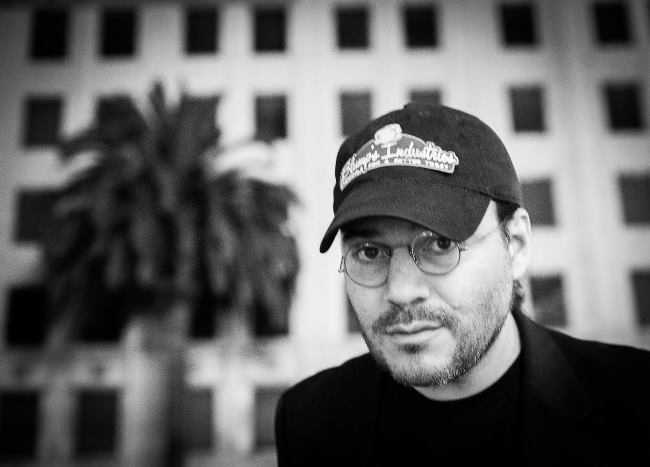
Two days. $1,000. A camcorder and pack of tapes. A cast of alcoholics, drug addicts (who were picked from heroin rehab LA), war veterans, strippers, incontinent senior citizens and homeless people. Home-sewn costumes and props from a party store. An avant-garde screenplay about a cow that a slaughterhouse sends on a luxury weekend vacation.
Giuseppe Andrews’ 2007 feature Garbanzo Gas was lovingly constructed out of that fever dream of a recipe, and went on to play festivals like CineVegas before taking a spot amongst the 50-or-so titles in the young moviemaker’s singular oeuvre. Now Andrews—and the gobsmackingly untraditional making of Garbanzo Gas—is the subject of Adam Rifkin’s Giuseppe Makes a Movie. It’s a documentary, but it might as well be a fairy tale, for both the movie’s gotta-see-them-to-believe-them cast of characters, and the miraculous way they come together to produce a truly original piece of cinema.

“I wanted to capture the time and the people, and let other people see what I got a chance to see,” Rifkin says. “I knew that it wouldn’t last forever.”
Rifkin met Andrews when he cast the then-kid actor in his 1999 indie hit, Detroit Rock City. At the time, the teenaged Andrews was already off a sophisticated cinephiliac deep end, Rifkin recalls, “watching Fassbinder and Bergman and Pasolini and Herzog.” When “technology caught up to people’s ambitions, and you could buy a pretty decent prosumer camera and start making your own movies,” the director encouraged his mentee to give it a go.
Andrews, who had lived for years in a trailer with his father (a musician whose peripeteian fall from fortune the film addresses coyly), assembled a ragtag group of friends, with such names as Vietnam Ron and Sir Bigfoot George, from the corners of his hardscrabble life. Over the next decade he shot 30 films with this unlikely troupe in and around the Ramona Mobile Home Park in Ventura, California.
Like some kind of demented Joe Swanberg parody, Andrews makes his movies for as little as he can (sometimes a few hundred dollars), uses the same collaborators (“this repertory company,” Rifkin says, “of addicts and winos and derelicts”), produces new work with blinding prolificacy, and writes, shoots, edits, and scores everything himself. Clad in a wetsuit (Andrews’ preferred directing uniform, for the aerodynamics), Rifkin captures a spindly, explosive cinematic visionary. His style cheerfully throws continuity out the window—that logic is secondary, he says, to a movie’s “vibe.” It’s all jump cuts, close-ups, in-camera effects; he clutches a crumpled chicken-scratched script in one hand, camera in the other, as he feeds line after absurd line to his actors. Which is not to say that his brand of good-naturedly perverse dialogue is bad; after all, “I’ll wine and dine you, douchebag, and open the door / I’ll take your stank poontang out on the floor” has an almost iambic cadence to its acid-tripping meter.

Call it Outsider Art at its most inclusive. Rifkin was struck by the charismatic Andrews’ affection and respect for his tribe. “Giuseppe had a magical way of bringing these people—genuinely the dregs of society—together. They did things for him that they never otherwise would have done in a million years. He was a pied piper.” Despite the fact that he can only pay his cast $75 or less a day, plus alcohol in the way of craft services, there’s no element of exploitation to Andrews’ unusual methods. “He created a family atmosphere where they would belong. He didn’t judge them; he included them in his artistic process. They felt safe. They were movie stars in his world. I find the whole group that he assembled, what they feel about themselves, and what he means to them, to be very touching.”
Rifkin himself has been trying vainly to get ahold of the individual members during his documentary’s festival tour. One of them he located “refused to come to a screening or be seen on the local news. We surmised that he probably had a warrant out.” (Andrews, on the other hand, is living in Austin, but Rifkin says his social anxiety prevents him from doing press. Visit his website and online store here.)
The question at the center of Giuseppe Makes a Movie is why we make movies against all odds—more odds, in fact, for some than for others. There’s “almost a desperation” to Andrews’ elemental need to create art, says Dougal in the film. But look at the bedraggled, endearing faces of his motley crew at the Garbanzo Gas wrap party—their evident delight in this endeavor, ludicrous to some—and the answer is clear: It’s the joy of telling stories and sharing them with the people we love.
“I like the idea that we live in a world where Giuseppe Andrews is given the freedom to do only what his heart tells him to do,” says Rifkin. “I just hope he gets to keep doing that, and only that.” MM

Giuseppe Makes a Movie was released in October 2014 and is now available on VOD, courtesy of Cinelicious Pics. This article appeared in MovieMaker‘s Fall 2014 issue.
